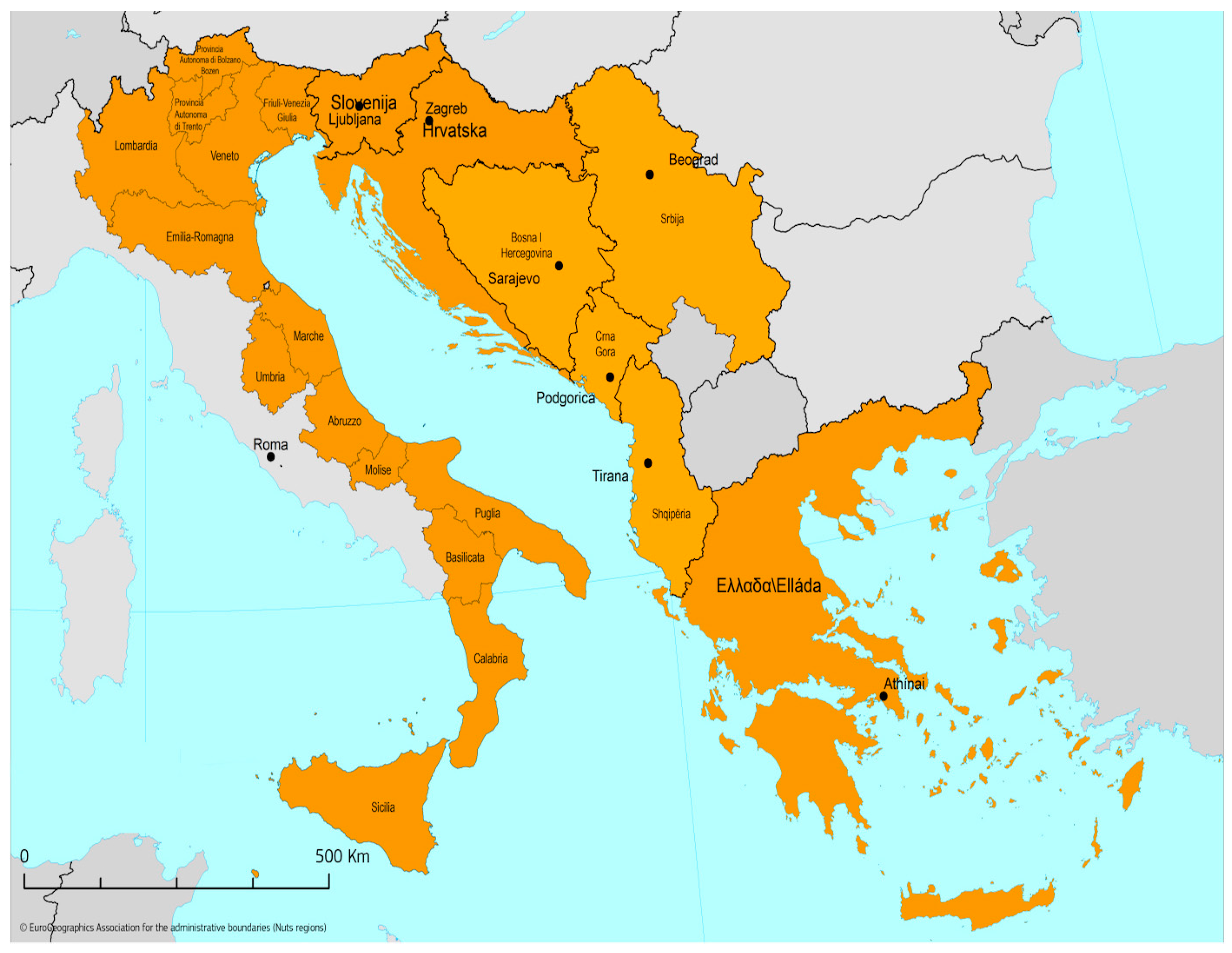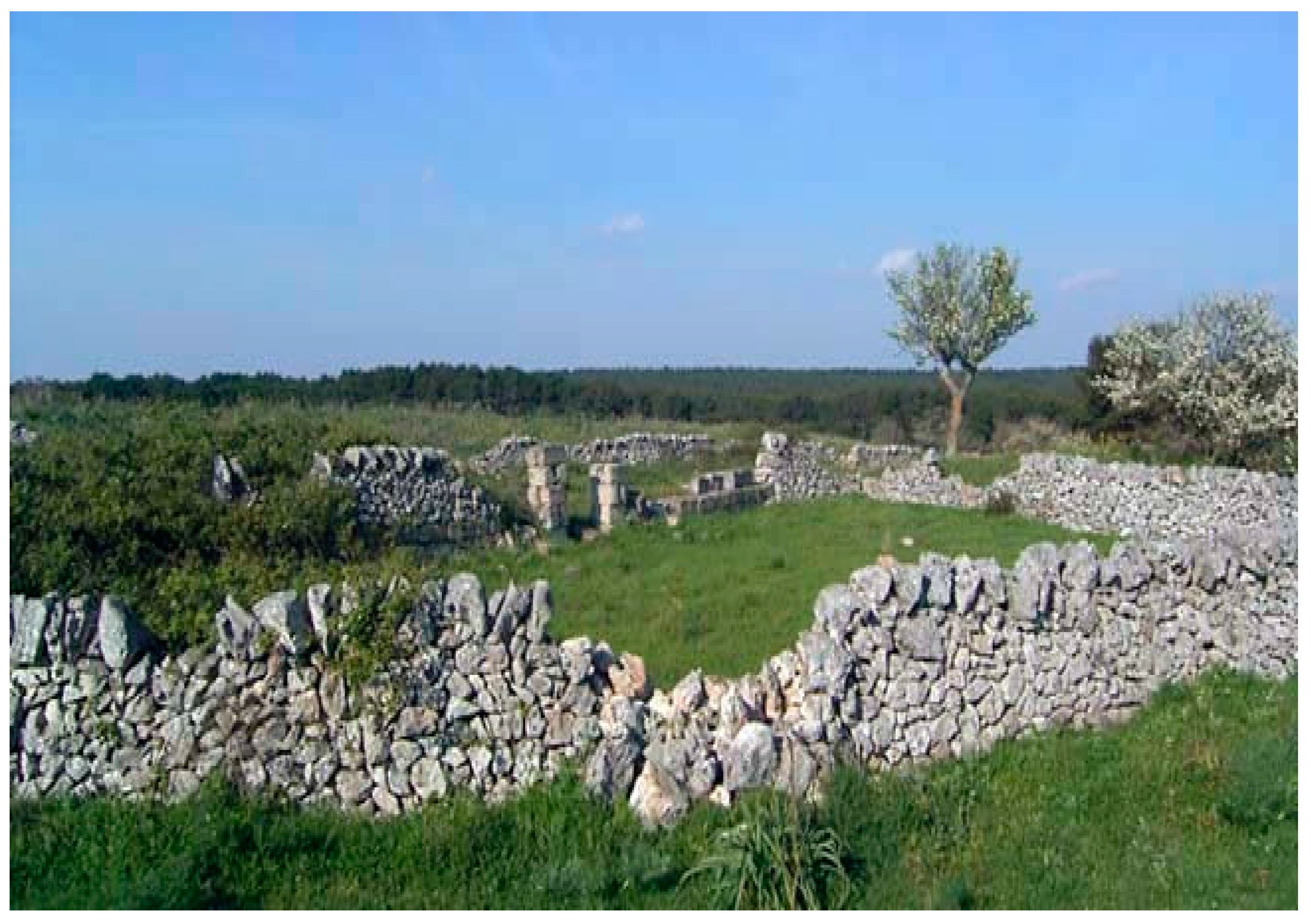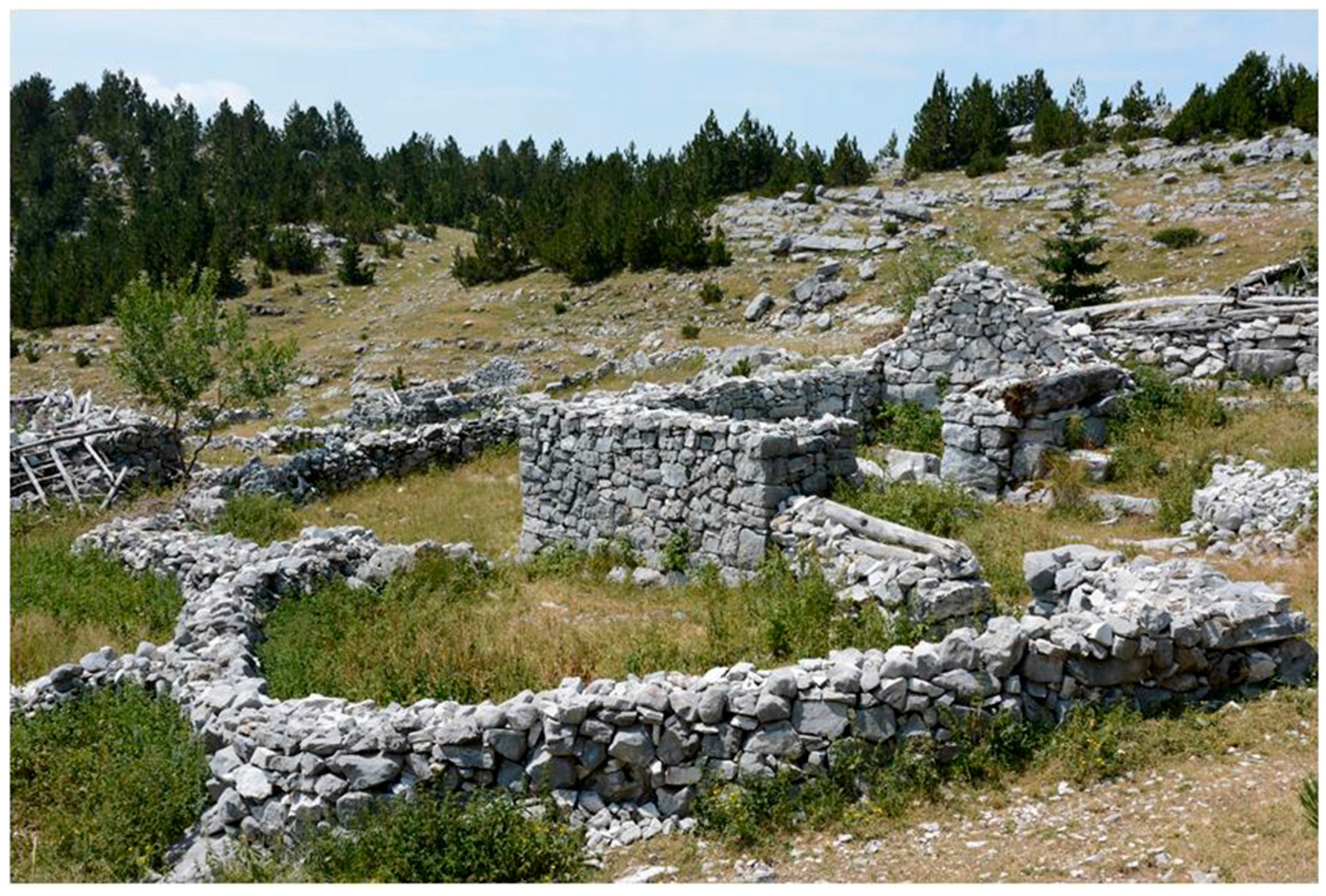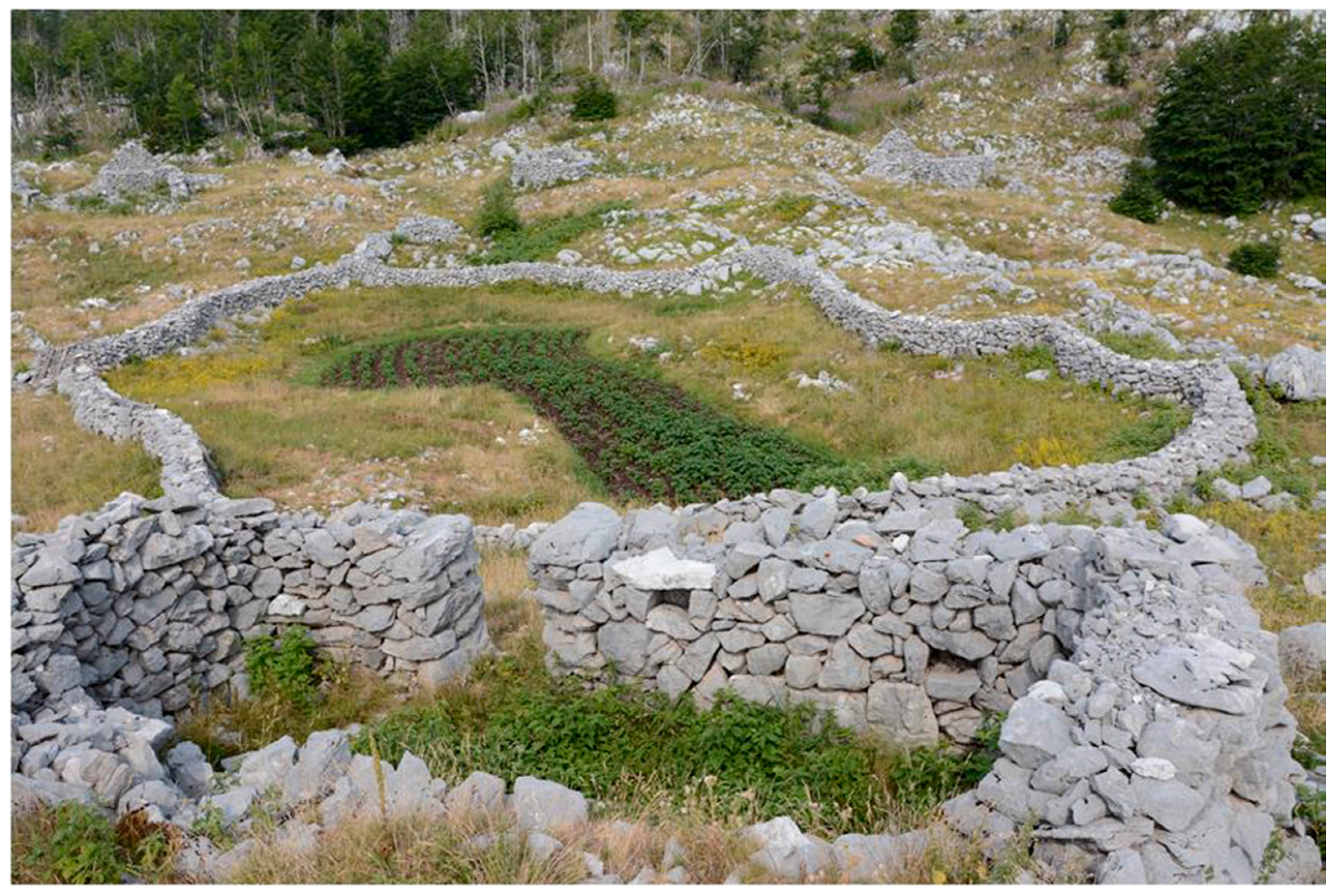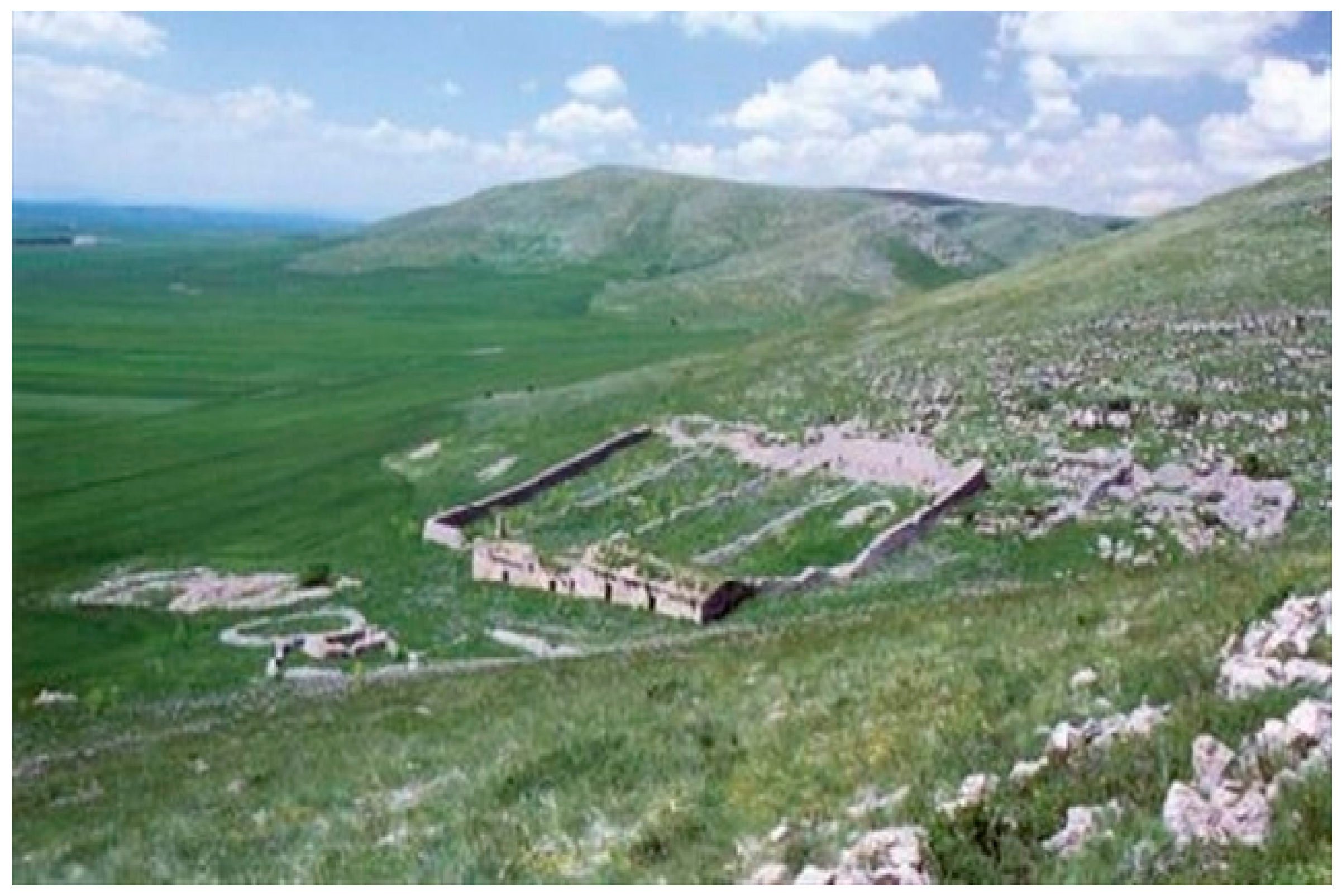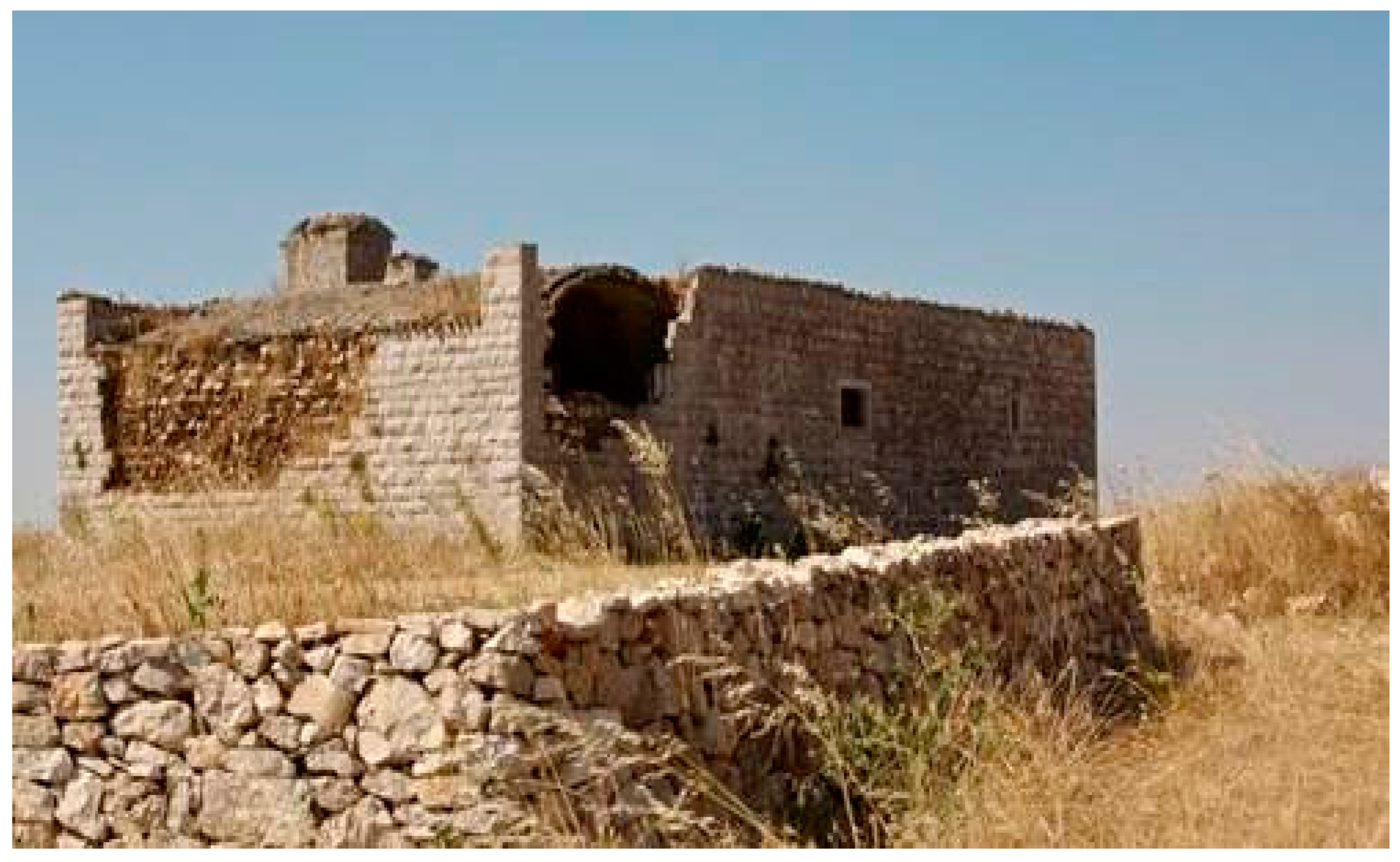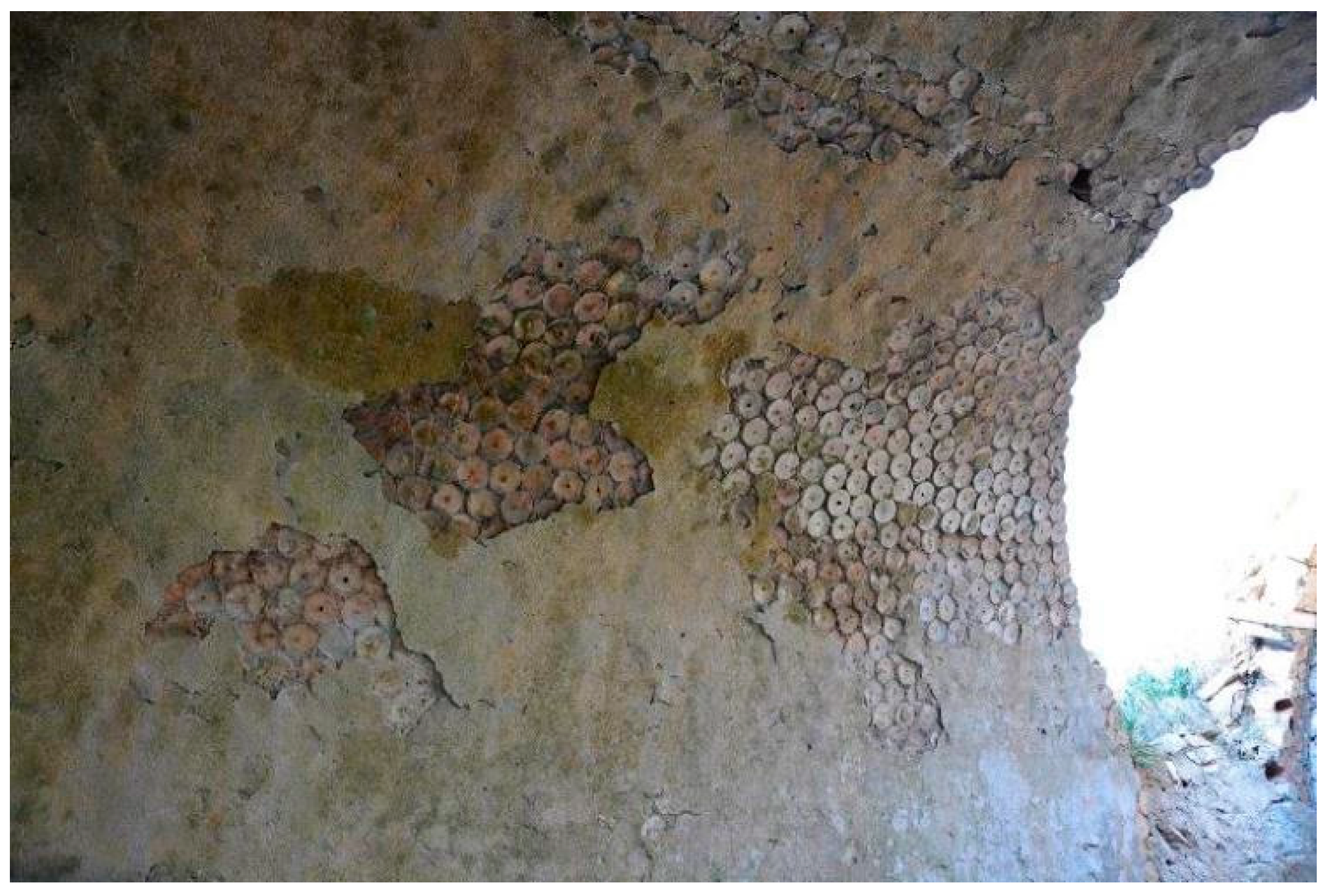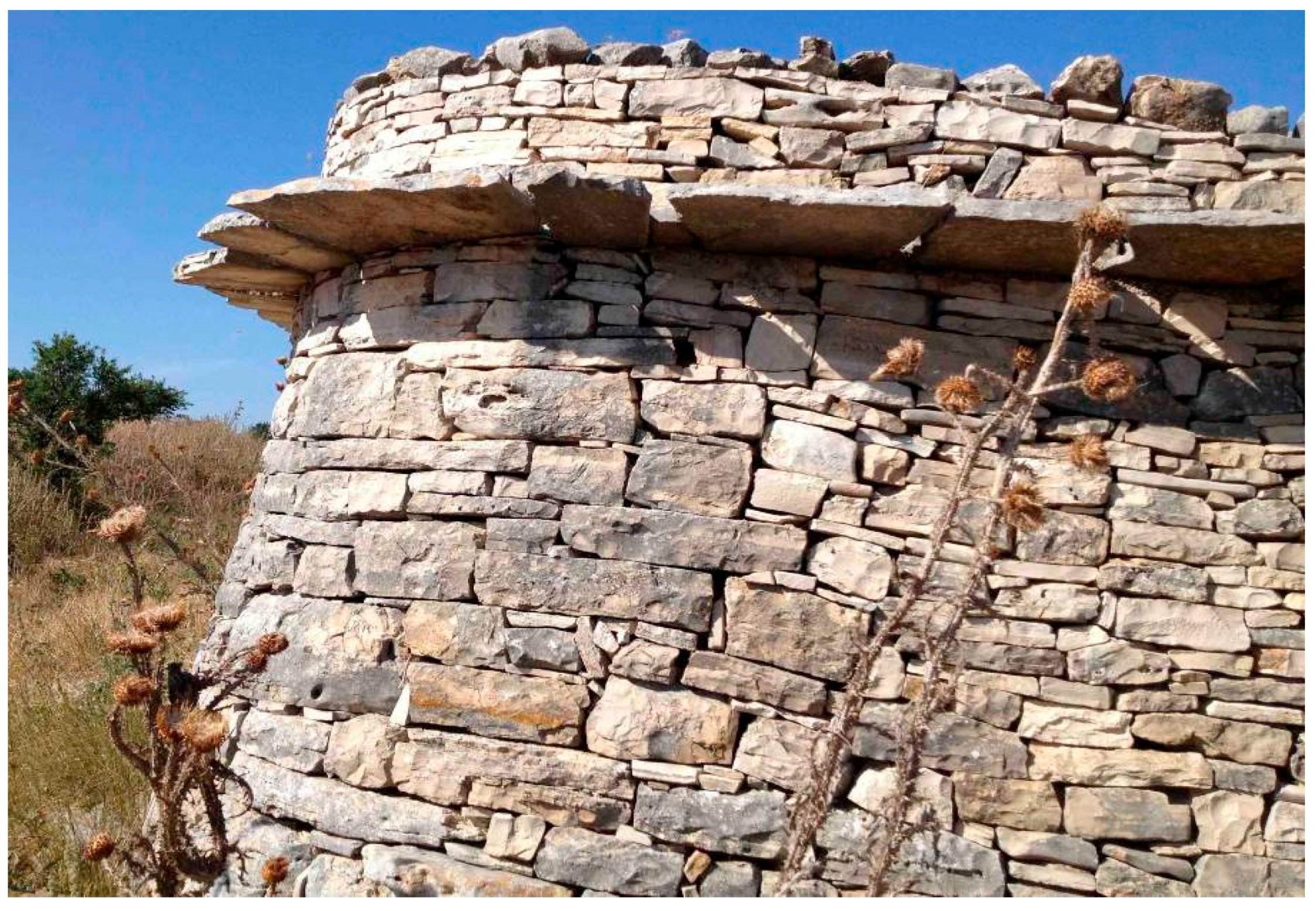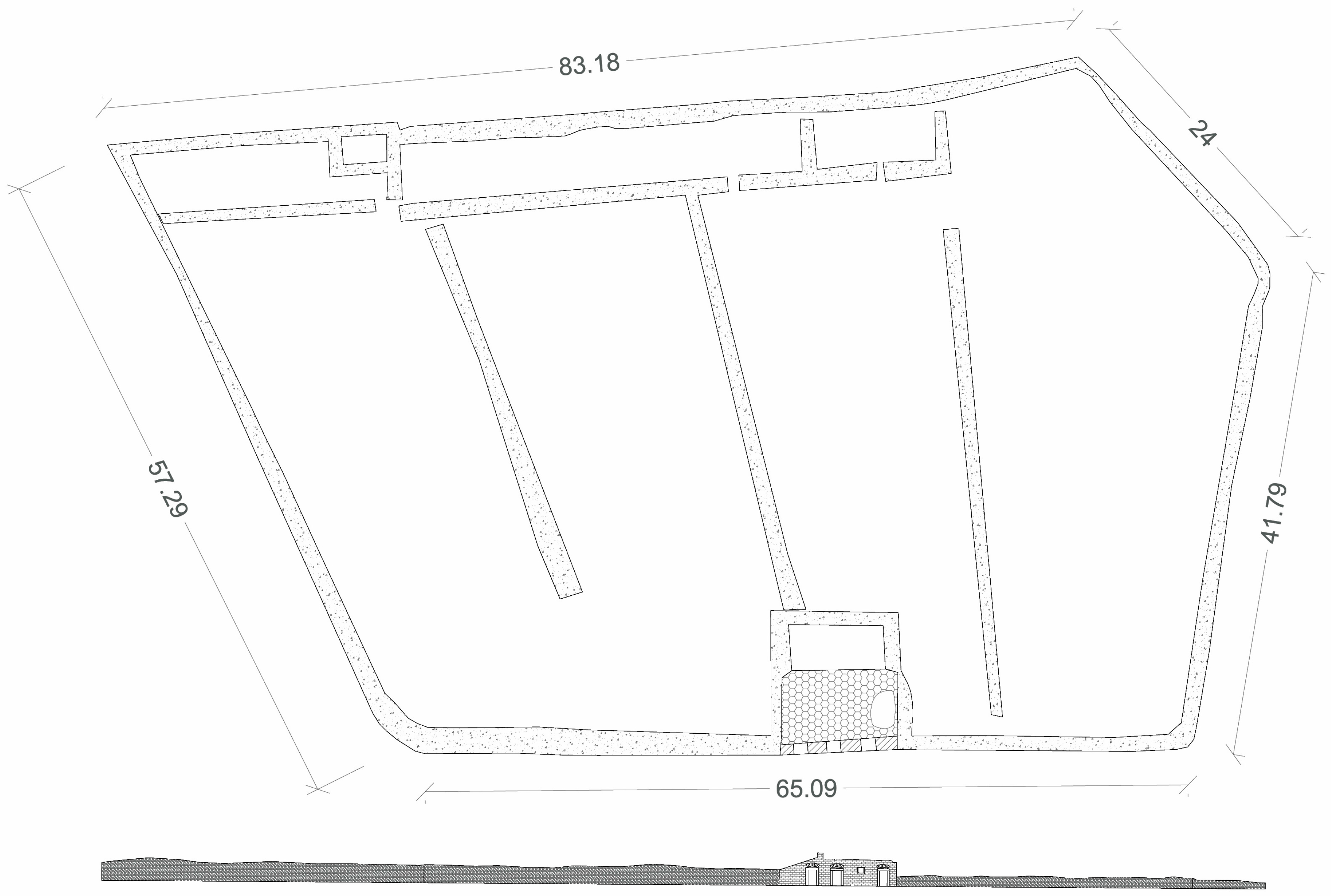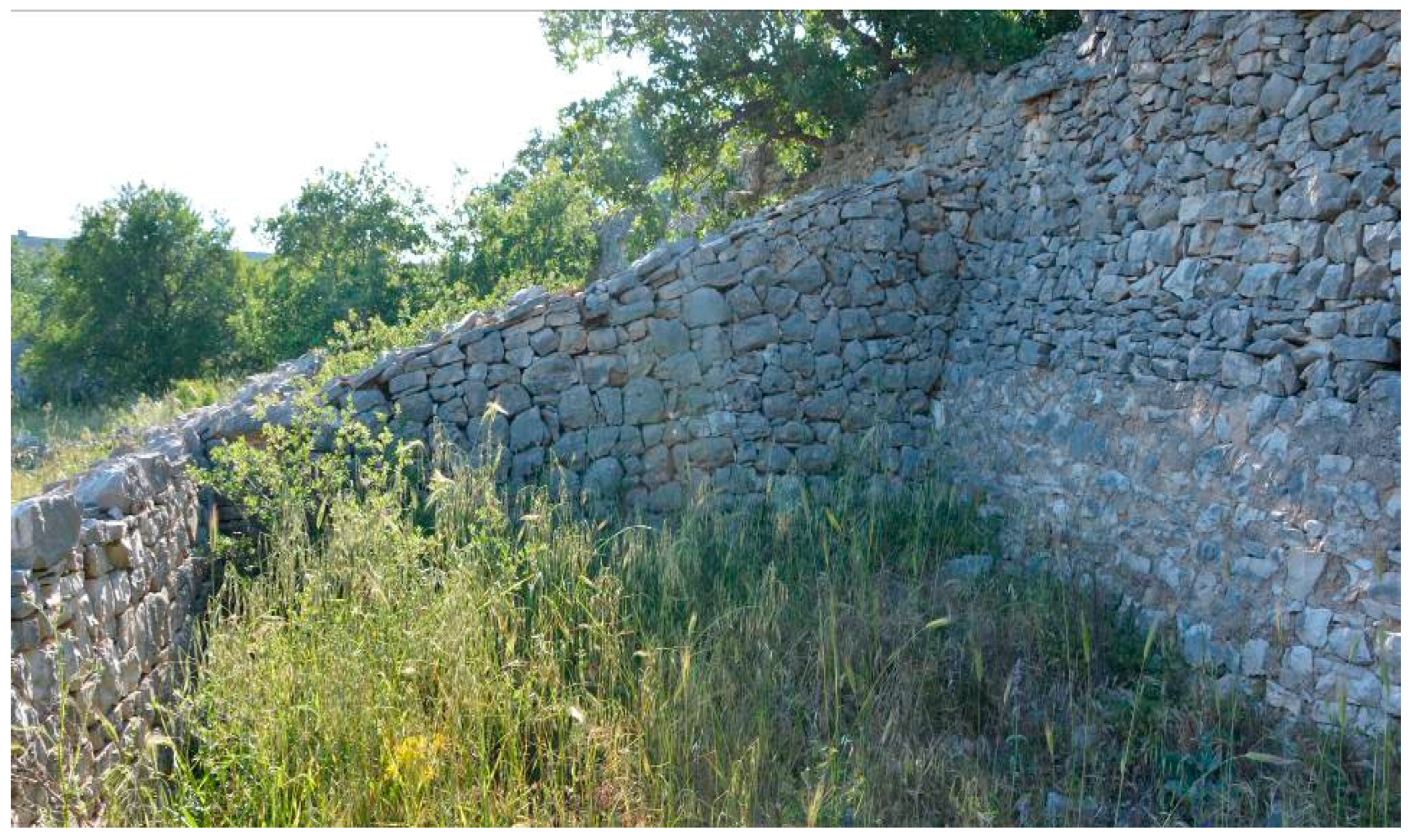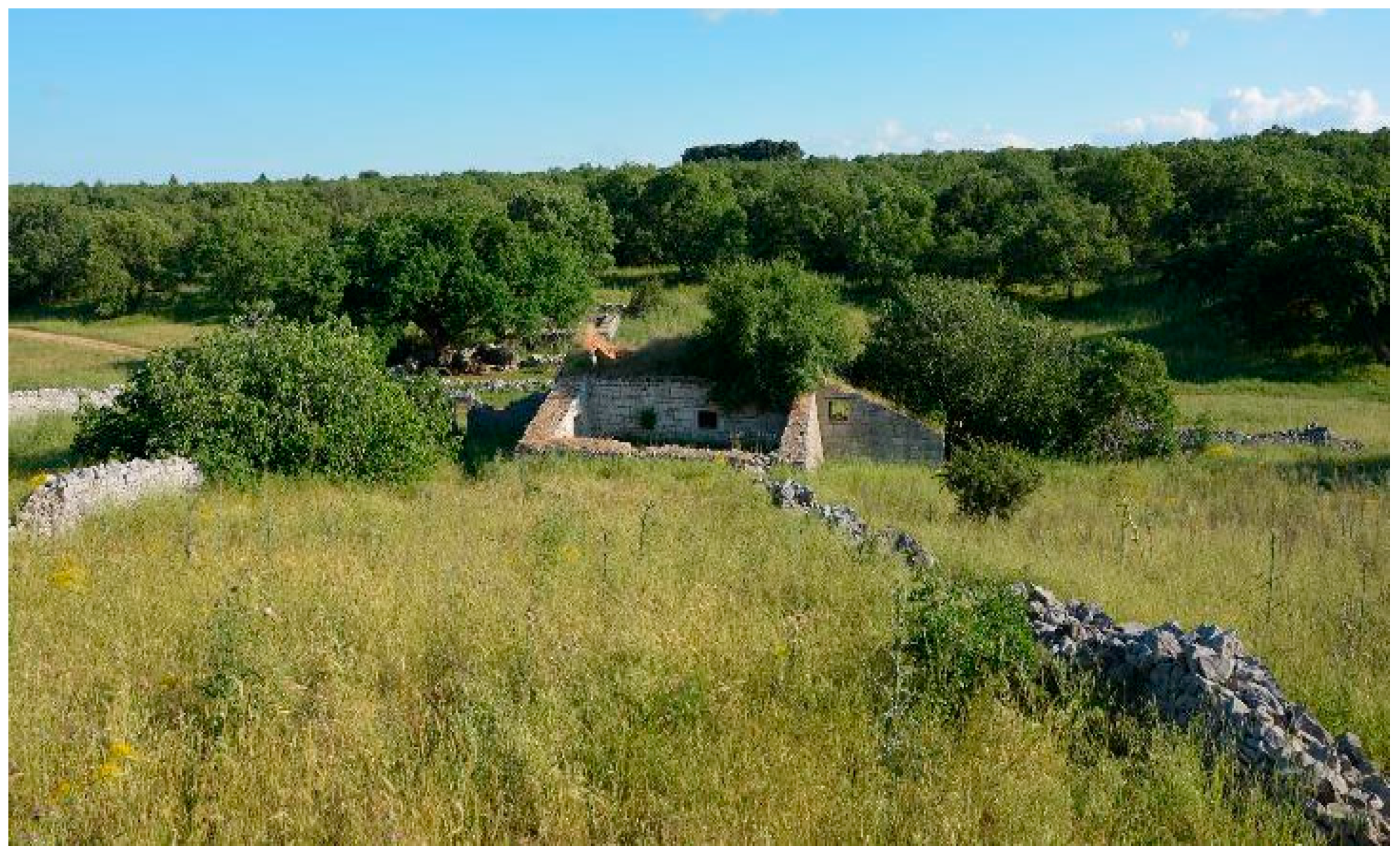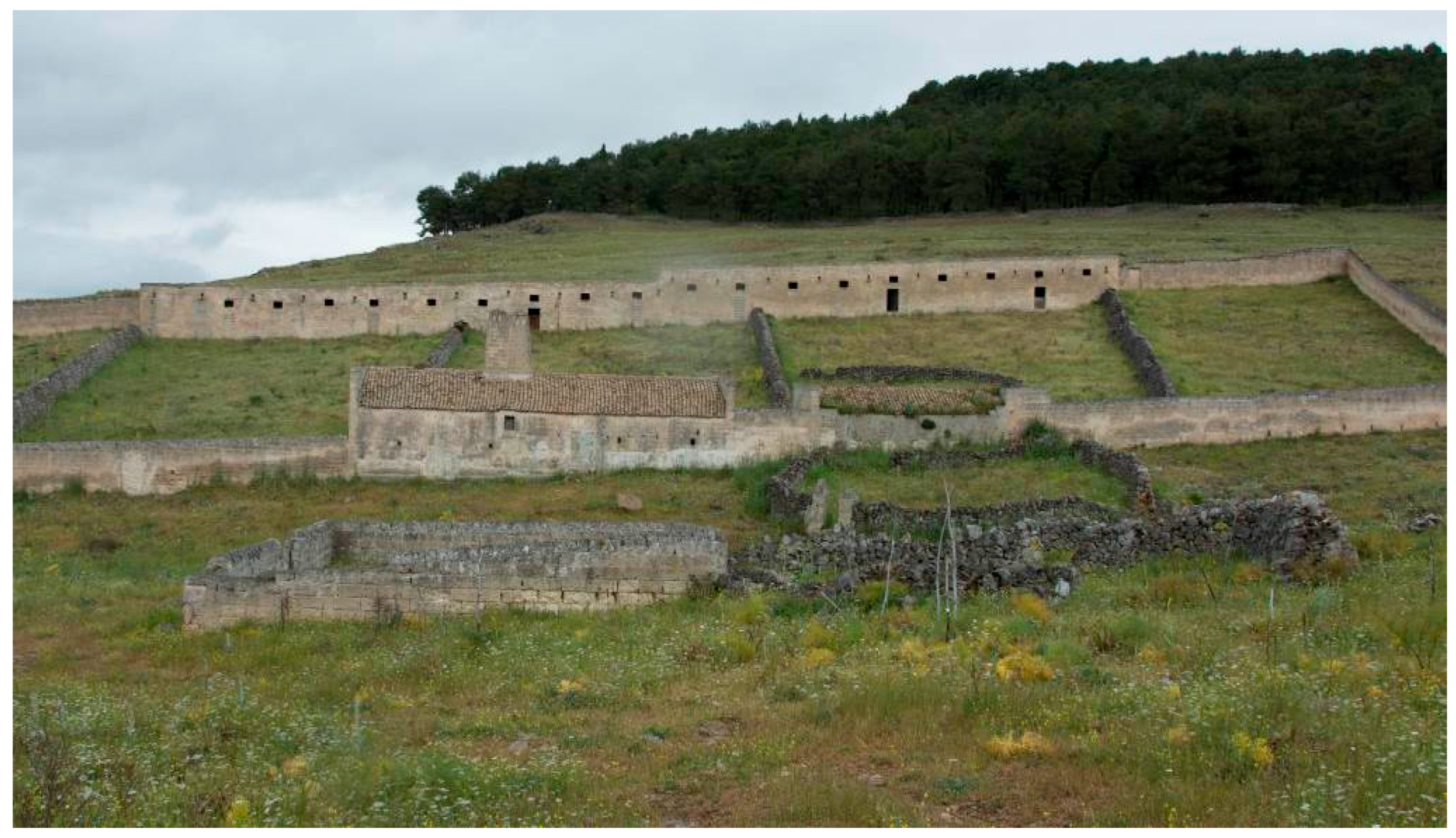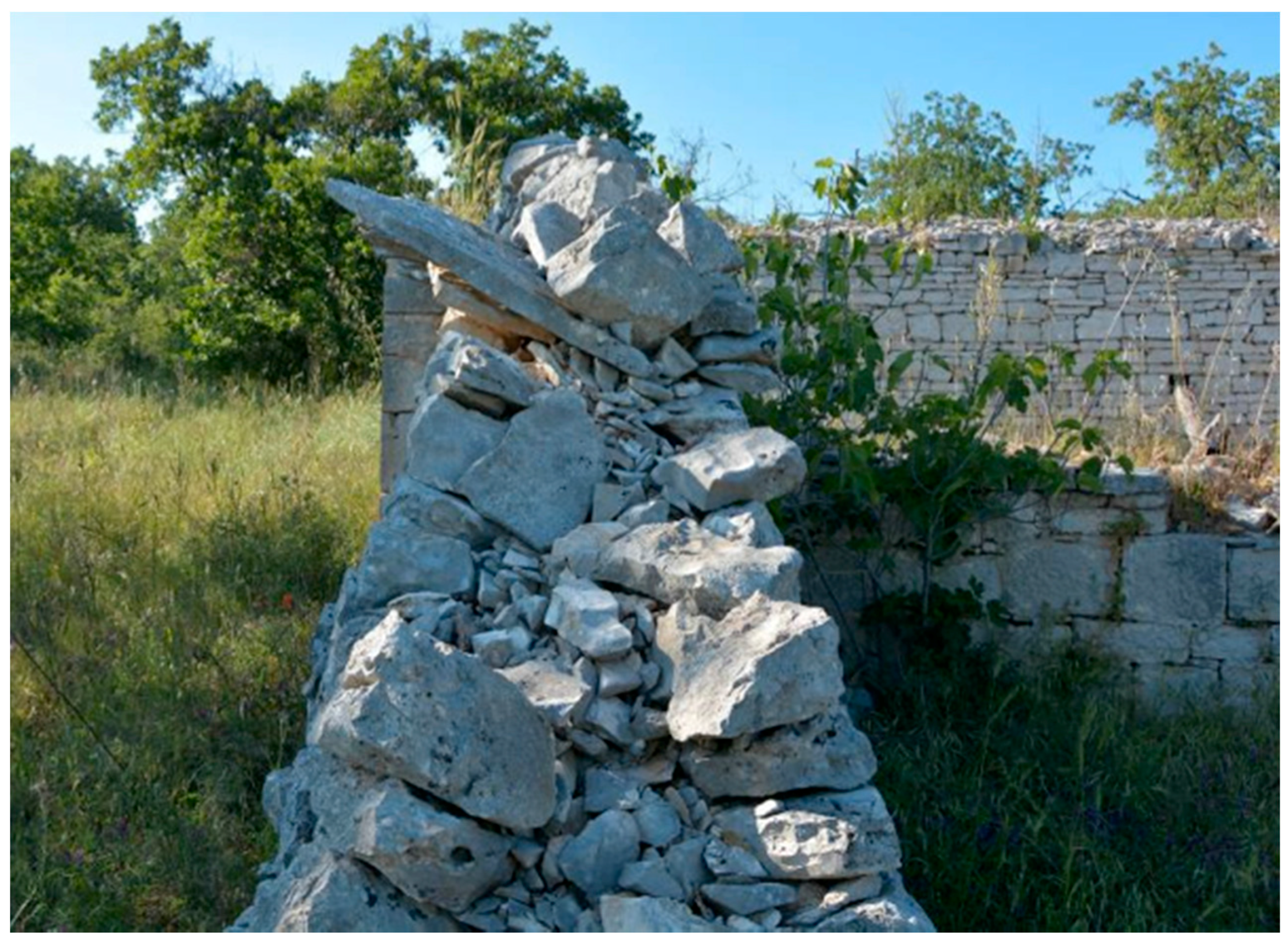1. Introduction
The growing of a modern society, especially of its social and economic structures, is often legible through the architectural structures having often hosted, as protagonists, some of these significant transitions. Farm buildings are one of the most intriguing examples of original technical and scientific issues: designed to host biological productions, there is no other comparable example in the wide epistemological sector of building construction. The birth, growth and development of living vegetal or animal organisms contained
inside these volumes raise architectural and technical issues with no similar comparison in other building sectors. Aimed at producing optimal environmental conditions for plants and animals, while at the same time protecting the hygiene and health of workers involved in the daily operations of the care of living organisms at different stages of their development, the rural building constitutes a unique and unrepeatable technological model [
1,
2].
The originality of what happens inside the farm buildings corresponds, indeed, to what happens
outside of them. The role that the buildings have historically played is strictly connected with the surrounding environment, due to the need of the farmer to live in close contact with agricultural land and animal husbandry. While the organization of human beings involved in the activities of the industrial or tertiary sector allowed aggregation in urban centres, the need to live in constant contact with the agricultural production developed a synergetic function of close proximity to the extra-urban land. This led to the spread in rural areas of many examples of buildings that served as buildings for farming, storage and processing of agricultural products constituting, at the same time, housing for the farmer and his family. This form of settlement has been, and still is, a unique way by which humans have populated, in harmony with the natural elements, the agricultural land, joining the agricultural production needed for human nutrition with the control and care of extra-urban land. Therefore, the interventions made by man have often strongly influenced the agricultural environment and the visual perception of its landscape. As in many cases all over Europe, these factors led in the Mediterranean area to the realization over the centuries of many buildings that, designed in order to fulfill their primary agricultural role, now constitute a widespread heritage of irreplaceable architectural value, that should be given the highest consideration during the process of landscape planning [
3,
4,
5].
A very interesting example of farm building is one made up of temporary settlements, widespread over some Mediterranean mountainous or high-hilly regions, where the agricultural households stay with livestock during the summer season, most frequently for four to five months (i.e., usually from the end of May or the beginning of June until October). This traditional movement from the villages to the mountains is also known as vertical transhumance or nomadic pastoralism [
6,
7], whose main purpose is to use mountain pastures during the summer period for the rearing of farm animals and producing traditional milk and meat products, which is the main source of income for these households. In the present paper, some rural constructions built as corrals for sheep and goat have been analysed, since even the most attractive aspect is the finding of this type of buildings in different countries, discovering several points of similarity.
2. Traditional Rural Constructions for Animal Corrals
Rural constructions for animal corrals are spread all over the Mediterranean, mostly within countries located in the “Adriatic-Ionian Macro-Region”, an area [
8] that covers a part of Italy and most of the western Balkan countries (
Figure 1).
Within this area, in different countries, these constructions take traditional names, i.e.,: Jazzi in Italy, located all over the Southern regions, mainly Apulia and Basilicata; Torine, spread all over Montenegro; Mandres in Greece, mainly located in some areas of Western Macedonia, Epirus and Southern Peloponnese.
2.1. Traditional Stone Corrals in Italy: The “Jazzi”
In Italy, the traditional
Jazzi [
9] have been realized along slopes, sometimes in real caves, so-called “
Jazzi rupestri”. These dry-stone sheep enclosures (
Figure 2) are mostly diffused on the pastures of the upper hilly area—so called, “
Alta Murgia”—connecting the two adjoining regions of Apulia and Basilicata, an area crossed by the sheep-track connecting the municipalities of Melfi (in Basilicata) and Castellaneta (in Apulia). This entire route is dotted with farm houses and
Jazzi, still retaining the features of the vast pastoral spaces that extend over much of northern Apulia from the Middle Ages to the mid nineteenth century [
10].
A
Jazzo is a complex building with a functional and social type organization. Fundamental is the relationship with the site in which they are constructed, becoming a key point for local economy. These buildings are chiefly shelter for animals and a first point of production, built with material locally available (
Figure 3), using a perishable material for roofing systems.
The first use was likely in the area around a monastery [
11], where these buildings had to become a shelter for the flocks, allocating sheep and goats for the night, placed in an area not far from the monastery, having indeed a direct control over the flock, and protecting the animals from the predatory attacks. At today’s knowledge, we can’t rule out that the presence of these rural buildings near the monastery was the first nucleus of
Jazzi; these admissions should also be sought over the hills surrounding the valley: indeed, for their allocation, soils with a minimum declivity were typically chosen, also in order to ensure a smooth flow of rainwater, having adequate natural protection from cold winds from the north as well and, the most important factor, basing the choice of location of plant on exposure to sunlight.
Many “Jazzi” were then built in connection with the traditional transhumance activities, a practice that, as in other Southern Italian regions (Molise and Abruzzo), dates from time immemorial. They were realized in strict connection with the traditional sheep-track network, traditionally named as “
Tratturi”, enjoying a long documented history until the 1950s and 1960s, with the advent of alternative road transport. The
Tratturi pathways permitted the passage and grazing of herds, principally sheep, and attracted regulation by law as far back as the 17th century.
Tratturi are now a public property and subject to conservation by law protecting cultural heritage. The Molise region has proposed the
Tratturi network to UNESCO as a world heritage [
7].
2.2. Traditional Stone Corrals in Montenegro: The “Torine”
In Montenegro, the
Torine—corrals for sheep [
6]—have usually been located next to cottages (
gladas), both for the ease of work and protection from the wolves. Their size and shape vary, with the largest ones having found a new use in contemporary times. In southern and central parts of the country, drywall
torine prevail, while the wooden ones are dominant in the northern areas. Being the best fertilized areas in katuns [
12], they provide the excellent conditions for growing potatoes [
13] in areas where the cattle grazing activities are abandoned or decreased (
Figure 4 and
Figure 5).
Generally, torine follow the logics of the terrain, both in the size and the shape. It is common that the corral encircles small depressions in the ground, provided easier keeping of the flock inside, or connecting the existing rock formations. They are, usually, built with less precision than traditional drywall housing objects (gladas), with the main differences in thickness and composition of the wall itself. While the gladas’s drystone wall is composed of three vertical layers (external and internal made of bigger, carved or partly carved stones, with middle one, made of small stones who fill the space between external and internal, providing mechanical cohesion and thermal insulation), the walls of torine are mostly made in only two vertical layers. In areas where the quality stone is available in larger quantities in close vicinity to the settlements, there are examples of excellently built torine, whose walls do not lag much behind the local gladas’ walls in construction quality, but such examples are pretty rare. Torine are around 1–1.5 m in height, 50–70 cm in width. On the top of them, they were usually covered by broken, thorny branches or, in the later period, with barb wire, to provide the better protection from the wolves.
Despite the geographical distance, each one is located in very similar geomorphological contexts, where sheep farming is fundamental for the local economy. Moreover, the local hilly environment makes impossible the cultivation of fields—for example, the production of grain. Over the centuries of history, these rural structures become real collection centres, rising mostly close to major roads and cattle tracks transhumance along hilly paths, becoming a part—often underestimated—of the local heritage. This aspect must be enhanced and included in a context of “rural planning”, which embraces rural buildings and local road system, considering the rural landscape as a pivotal component of the cultural heritage.
Along with housing and specialized auxiliary objects, the torine are the most widespread agricultural constructions in southern and central Montenegrin mountains. Their importance is visible not only for the art of drywall building, but also for being the historical evidence for the amount of cattle brought for rearing at mountain pastures. From the contemporary perspective of visible abandonment of katuns and absence of cattle from vast grassy areas, torine testify about the different situations in the past. Almost every glada had a pertaining torina, some even more of them. Their sizes vary, but they are generally suitable to provide the shelter to 50–100 sheep, which presented the average flock. Although we lack in precise descriptions and data in archival documents, such number, size and disposition of these constructions can help us in getting a picture of traditional mountain landscapes and amount of cattle present.
2.3. Traditional Stone Corrals in Greece: The “Mandres”
In Greece, a further example of dry-stone corral is one coming from etno-archeological assessments [
14] conducted on shelters for sheeps and goats in the mountain pastoral sites such as those of Sarakatsani shepherds of the Zagorochoria area on the Pindos mountain and those of the Territorial District of Grevenà (north-western Greece). Here, the summer “
stani” (sheepfold) is a corral presenting in over 50% of cases an exhibition oriented systematically towards the southeast. [
11]. One
stani is composed of the following features: “
korda”, holding pen or corral, constructed of brush, upright posts, wire or wooden fencing; “
strunga”, milking enclosures, also constructed of brush, or upright posts and wire mesh fencing, with two stones that form the “
mati” (eye) of the pen, where herders sit and milk the ewes; “
kalivi” or “
konaki”, the hut, made with stone.
Other dry-stone corrals, strongly linked to mountain sheep farming area in Greece, are those of Crete (
mitata corrals). During the summer transhumance, there are dedicated areas for grazing (
madares) and for accommodation of animals and people. The latter are composed of stone fence walls (
mandrià) and of small buildings, partly of almost circular solid dry-stone (
mitato). Such constructions have a false-domed cover (
tholos type) exclusively composed of stones and were used for the production of cheese [
15].
The winter or year-round pastoral sites are known as “
Mandres”. A “
mandri” consists of the animal fold often built of stone and barns used for storing fodder. In recent years, the enclosures have been constructed with upright posts and wire fencing. In addition, several historic “
korda” constructed of dry laid stone walls were recorded. When historical stone-wall enclosures have been found, they are always situated near rock outcrops. At most sites, the “
mati”, or eye of the milking pen is made of two rocks about 5 m apart, where herders sit during milking as all ewes pass through one by one. The “
konaki” are less substantial than the stone masonry “
kalivi” of settled village herders [
16].
Most of these sheepfolds constructions were strongly linked to the transhumance organization, which has affected exponentially large portions of our geographic study area [
17]. Many of these, especially from the late Middle and post medieval Ages, were part of a system composed by a very structured sheep-tracks and minor roads of transhumance. Several studies have shown, however, that the seasonal movement of flocks has ancient origins and has affected various areas of Greece, especially Crete and northern Greece mountainous area, from the Neolithic onwards [
18,
19]. For historical times, they are also not lacking Greek and Roman literary sources related to these movements: in fact, this is the testimony of Sophocles’ King Oedipus (Sophocles, OT 1132) and the idylls of Theocritus [
20,
21,
22].
2.4. Common Characteristics of the Construction for Corrals in Different Countries
In all three of the countries, these rural buildings were built in mountain or high-hilly territories. They were constructed in some cases facing to the South—with a preferential exposure to the southeast, in order to use the location for the morning light—as well as along slopes so as to facilitate the natural outflow of rainwater and animal manure. Sometimes, these buildings were connected with a larger farm building, in some cases realizing more complex structures. In other cases, they constituted a self-standing structure, working in an autonomous way [
23].
In several cases, it is possible to distinguish different internal areas, connected to specific functions, i.e.,
shelter for animals;
shelter for the shepherds;
centres of first milking and cheese making;
shelter for injured animals;
haystacks.
Building materials were local and easily available in the territory, which means that sometimes they were of poor quality. Traditional building techniques used for stone constructions varied from the drywall or drywall grouted with mortar after the construction, until the direct use of mortar while building. The first technique was the most widespread for the objects built in older times or in areas without a road infrastructure. The second one has only been used for consolidation of existing objects built in dry-wall style, while the third one represents the more recent and currently most frequent approach.
Overall, some of these structures have been huge, and mainly composed of a wide enclosure, with internal division in four or five sub-areas (
Figure 6), separated by low walls, in some cases covered with a double-pitched roof (
Figure 7).
The whole structure was made of local stone, slightly refined, and put together without the use of mortar or plasters.
Roofs of the limited closed buildings were made with perishable material (generally wood or straw), rare cases with a first level of elevation and, where present, they were constructed with wooden beams. Although easier to construct, this housing design was less suitable for internal organization, so the square objects soon prevailed. The ashlar dimensions ranged from 10/20 cm to 50 cm for outdoor enclosures, while they were smaller in the case of covered structures (
Figure 7 and
Figure 8). The floor was often constituted by the pressed soil only.
Some common building characteristics refer to these structures in the three different countries. This nowadays constitutes again an historical proof on how local operators have adopted in different geographical situations similar techniques for solving the every-day-problems:
2.4.1. Water System
The shepherds had to provide, during the hot summer, water to the flock. In some cases, this problem was solved mainly by exploiting the slope on which the shelter stood: they have built in fact proper drainage canals, channeling rainwater into cisterns and troughs, then solving the problem of thirst in arid areas and possible swamping of the area.
2.4.2. Security System
The closed rooms ensured to shepherds a relative security against bandits and cattle rustlers, but more interesting is the herd protection system against other animals: in all cases, some bulging elements incorporated into the external wall are present, realized in order to prevent the entry to wild animals, called in Italian “
Paralupi” (“
Against-wolves”), protecting the flock from wolf assaults. Stone elements are embedded in the masonry, much overhanging from the line of the wall, which prevented the overcoming of the corral by the wolf (
Figure 9).
2.4.3. Productive System
In Jazzi, more evolved and complex Glada and Mandres were often a zone destined to a first dairy production. After grazing, the shepherds often proceeded with milking, during the early hours of the morning. Also present were chimneys for the boiling of milk and structures for the first path of cheese-making made with perishable materials.
3. Materials and Methods
In order to check the current situation of the traditional constructions for animal corral, a typological survey was conducted on two examples of this construction, both located in the Apulia Region (Southern Italy). They are:
Jazzo “Pellicciari” (also named “Jazzo Pantano”)
Located in the Municipality of Gravina in Puglia, (N40°52′37.18” E16°26′23.54”), this traditional Jazzo is built with tuff in the external walls and dry stone for internal partition and animal corrals. It is located on a hill. The total area is about 7933 m2.
Jazzo “Del Demonio”
Located in the Municipality of Ruvo di Puglia (N41°01′49.38″ E16°25′43.44”), within the National Park of “Alta Murgia”, it is built with dry stone, both in the external and internal partitions, except for an enclosed small cottage that was recently partially restored. It is located on a hill. The total area is about 4600 m2.
Both of these constructions were surveyed using the following instruments:
GPS Station—Topcon HiperPro (Topcon Corp., Tokyo, Japan).
Digital Camera—Nikon D7100 + Zoom Nikkor 55–300 mm f 3.5. (Nikon Corp., Tokyo, Japan).
Yardstick—for the manual survey of some details.
After the survey, each structure has been drawn in AutoCAD (Autodesk Inc., San Rafael, CA, USA), creating an electronic three-dimensional model of both these sites.
4. Results
From the relevant digital models, one plan and a main elevation is reported for each one of the surveyed constructions in the following figures (
Jazzo “
Pellicciari—
Figure 10;
Jazzo “
Del Demonio”—
Figure 11).
In both of these buildings, some common aspects were detected. They are:
The use of same main building material, i.e., dry-stone (
Figure 12);
A wide delimited area, i.e.,: 4600 m2 for Jazzo “Del Demonio”, 7993 m2 for Jazzo Pantano;
The internal division of corrals (
Figure 13);
Channeling of rainwaters;
Wall’s structure with a “
paralupi” protection system against wolves (
Figure 16).
Basing on the results of the typological analysis that was conducted, it is possible to report that most of these traditional rural constructions for animal corrals that were visited are currently abandoned, the survey having showed a structural and functional degradation that, in some cases, is worryingly advanced. This makes a possible restoration somehow difficult, unless undertaken at the cost of complex and costly restructuring in accordance with the original architectural forms.
Even if abandoned by several decades, these constructions appear anyway in structural conditions for which a sound restoration, coherent and respectful towards their traditional construction protocols, would be anyway possible. The use of traditional materials and building techniques in the restoration of cultural heritage is very important for the safeguarding of its value and authenticity. This is particularly important for rural architecture in which the use of local materials, i.e., those that could be found in the surroundings, is dominant, as well as the use of traditional building techniques that have been developed by generations of inhabitants in a certain area. The most traditional of rural constructions for animal corral were built of local stone, without binding material, using a dry-stone technique. The assessment and reconstruction of dry-stone constructions in the Mediterranean has been given increasing attention lately. The use of traditional and local materials in the restoration or maintenance of rural constructions contributes to preserving the overall cultural landscape. In addition, a very important part of this process is the revitalization of traditional techniques and crafts, which contributes to preserving the intangible cultural heritage as well. Bearing in mind that the successful protection of rural heritage depends on the involvement and support of community, continuing use and maintenance [
24], the revitalization of traditional building techniques, especially the dry-stone method, and education in this field are very important.
5. Discussion
In a period of growing interest towards the traditional rural buildings for their recovery for cultural purpose, rural tourism activities, etc., a sound analysis aimed at assessing possible ways of recovery, depending on their deterioration, the traditional vocation of the territory and the opportunities offered by the surrounding environment, becomes essential. In any case, a recovery program of such a vast and important heritage should begin with the systematic cataloguing of all types of these lodgings all over the Adriatic-Ionian Macro-Region [
13], since this area fits very well for this aim, due to the common characteristics linking these buildings in different Countries, thanks to the activities of transhumance that were traditionally practiced there. The historical peculiarities embracing this area are indeed characterized by moving bucolic communities which have left, together with their traditional building ability, also an immaterial heritage linked to their way of life, sometimes even celebrated by some artists, like the Italian poet Gabriele D’Annunzio [
25].
Traditionally, these places were maintained thanks to their continuous conservation by the shepherds themselves. Now, after their complete abandonment, the valorisation of these constructions, in close synergy with all the assets offered by the whole rural landscape, would play a key-role in the recovery of abandoned structures having a significant historical and cultural value, then contributing to the economic and social development of the area in which they are located. Montenegrin torine are the inseparable part of a traditional katun’s organization and mountain landscape in whole, presenting the picture of cattle’s accommodation in the same way as the traditional housing objects show the same story for humans. On the other hand, their performances fully enable their use even in contemporary procedures of livestock rearing, especially having in mind a drastically reduced population of wolves and other modern devices that facilitate taking care of such accommodated flock. In southern and central parts of Montenegro, where the amount of quality stone for building is present in appropriate quantities, the torine will keep their place in any prospect of sheep breeding for many years to come.
These structures played an important role, in a social and economic system, but also a fundamental modification in the course of general social progress carried along the lessening of their traditional meaning. The integration of the activities on linking the existing traditional food chain to new in situ tourism offer, along with protection and affirmation of cultural-historical heritage values as specific characteristics and advantages, can easily present the winning formula for sustainable development of these mountain and high-hilly areas. Most of them could indeed host different forms of rural tourism (i.e., agro-tourism, environmental tourism, cultural tourism, sport tourism, etc.), provided that suitable plans for the synergistic restoration and valorization of the sheep-track networks (as new bridle tracks, mountain biking, etc.) are implemented. Similar actions seem indeed crucial in order to improve the sustainable development of these extra-urban areas, that, in several cases within the Adriatic-Ionian Macro-Region, have particularly suffered from depopulation and abandonment of the traditional activities, currently re-discovered within the research of a more sustainable way of life [
8].
New businesses could be hence generated, in association with new forms of hospitality that, thanks to the presence of a lively local community, may offer acquaintances with a new lifestyle, rather than a period of pure holiday, giving visitors the experience of being “temporary residents” rather than “traditional tourists”, exploiting mainly the most traditional sectors such as local gastronomy and handicrafts, and fostering new activities capable of repositioning the territory on the tourist market, such as events including specific training courses in traditional sectors (local cuisine, sports, artisanship, etc.). This aspect alone is capable of generating enough economic turnover because it “de-seasonalizes” the demand, thus contributing to the emergence of new tourist destinations that are usually off the beaten track.
6. Conclusions
The rapid turnover of social models, which occurred in the last century, led to appreciable consequences on the built heritage in general and in particular in rural areas. The analysis that was carried out about the rural constructions for animal corrals in some countries of the Adriatic-Ionian area has revealed the existence of several common architectural characteristics. Most of these buildings, realized during the past centuries, are currently abandoned, since modernization took over the old practice. Nevertheless, thanks to the role they have played during past centuries in enabling the evolution of human activities, they constitute living witnesses of an old and wise capacity of our forefathers in designing buildings in a way that fosters the natural components ability to maintain optimal environmental conditions inside “living” buildings, where humans, animals and crops—in one word, living organisms—could find better conditions than in the open field. These objects, both housing and cattle protection purposed, are not only historical relics. They present a solid base ground for traditional agriculture renovation projects, providing, with minor adjustments and additions, the needed preconditions for many different uses in contemporary times.
Within the general current re-discovery of agricultural heritage and genuine food techniques, the valorisation of traditional construction material both for building purpose and for the realization of some components directly connected with agro-food production may contribute to the improvement of agricultural production within the concept of sustainable development. Rural tourism seems to be among the most currently intriguing activities aimed at the sustainable growth of the agricultural sector joined with new ways for a sound valorisation of the agricultural land, which can be enjoyed in close contact with naturally untouched landscapes, often coupled with the unique opportunity to personally look at the preparation of traditional genuine food products and to taste and buy them. The recent growing research of new ways for widening sustainable tourism opportunities led, in many European countries, to the valorisation of some farmyards, together with the working activities usually conducted there. In this framework, a suitable restoration and functional requalification of some traditional rural corrals play a considerable role, in which a suitable use of traditional building material may contribute to a significantly positive effect. It seems obvious that these stone monuments are to be studied and highlighted within a network of tourist-cultural thematic routes, based mainly on the concept of connection between marine and mountain areas, characterized by the tradition of transhumance. The revitalization of some sheep tracks with the visit of some animal corrals and their connection to the nearby archaeological sites and agro-food farmhouses, can be made through archaeo-trekking paths and functional restored corrals, especially chosen for the performance of cultural activities or for temporary—or permanent—thematic exhibitions. The purpose is to place these monuments of the recent past, thus far falling into oblivion, within a system of network paths for the knowledge of their architectural forms and for their importance to the transhumance civilization and sheep farming in general.
In the context of technological advancement, in which modern practices should meet up with landscape changes and climate change, these types of pastoral structures, which were perfectly integrated in the ancient landscape, today could offer a testimony of traditional and ecological human practices from antiquity until recent years. In the perspective of giving such kind of studies in the future new interests for the creation of special training courses to revitalize or to revive traditional crafts and specialized workers (stonecutters, cultural workers, etc.), the study of these “archaeological” contexts can provide an important contribution in the design of regional landscape plans (for Basilicata region—Italy—these are still missing!) for the rehabilitation of monuments and their common rural landscape characteristics.
